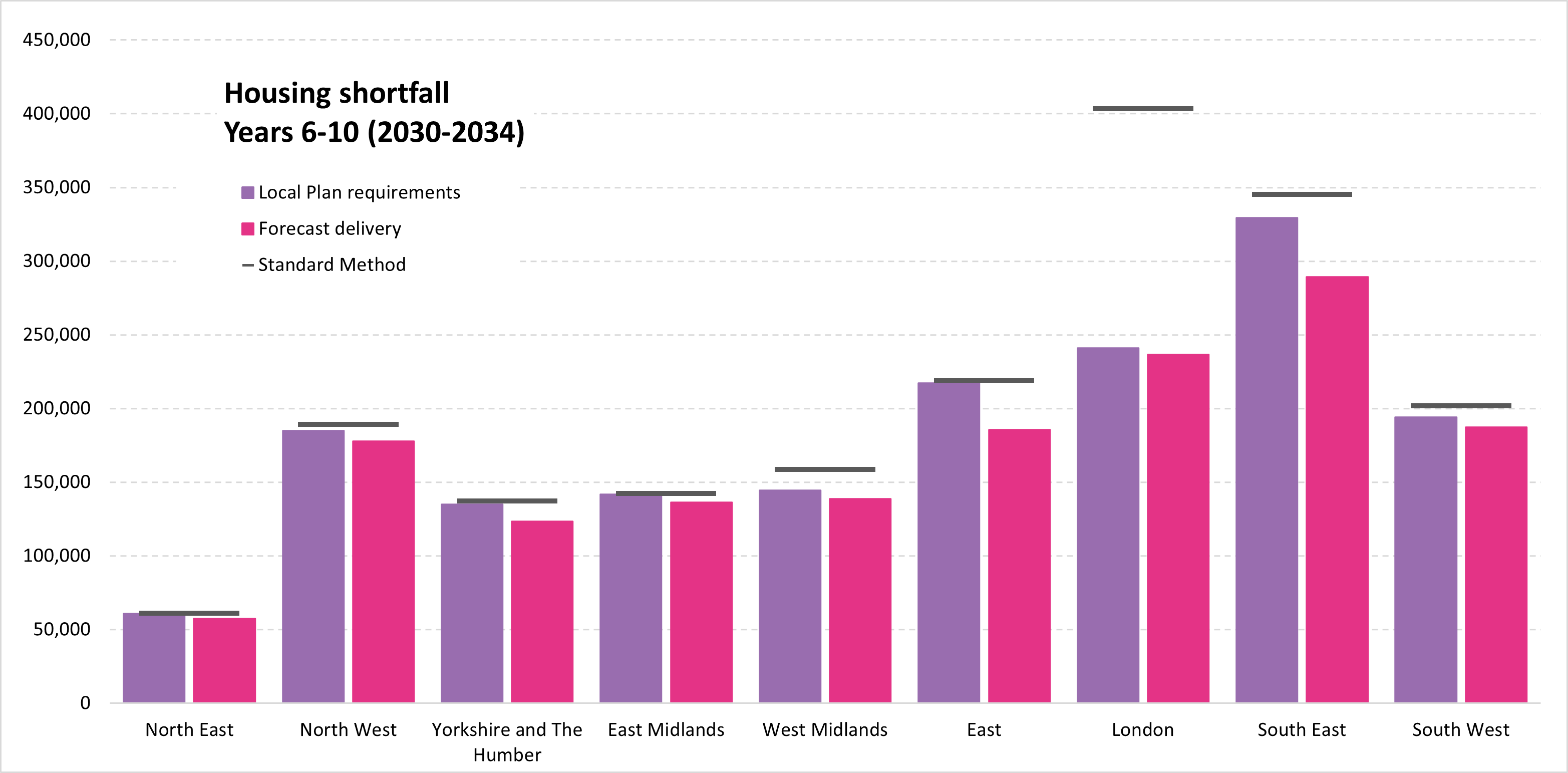In a
major set piece speech from the Prime Minister and Deputy Prime Minister, the Government has set out six milestones as part of its plan for a decade of change.
Key for the planning and development industry, is the “Rebuilding Britain Milestone”: the Government has reaffirmed its intention to deliver 1.5 million homes within the term of its Parliament, alongside a “new commitment to fast-track planning decisions on at least 150 major economic infrastructure projects”.
The Government is asking that it be measured against this target, which is one of two milestones within the ‘Kickstarting Economic Growth’ mission of the Government’s newly announced Plan for Change. This plan is intended to build on the seven pillars of the growth mission set out in the Budget, and offer a refreshed signal of the priorities for funding and reform.
The 150 infrastructure projects commitment is new, unlike the other milestones which largely draw together earlier announcements. Adopting the antithesis of Homer Simpson’s approach, the overarching message appears to be – if something is hard to do, then it is worth doing.
The Prime Minister, announcing the Plan for Change, said “Populism isn’t the answer to Britain’s challenges… ‘Easy answers’ won’t make our country strong”. And described the planning system as “A blockage in our economy that is so big, it obscures an entire future”.
There were further pledges to reform the planning system – the industry awaits the new NPPF and Devolution White Paper, both expected before the end of the year, as well as the Planning and Infrastructure Bill. The announcement of ten-year strategies for housing and infrastructure has also been promised in the spring. The strategies will include government priorities, plans to deliver, and a pipeline of projects for investors and supply chains.
Recommitment to the “stretching” 1.5 million homes target.
Three days ago, the Secretary of State, Rt Hon Angela Rayner MP, reiterated the Government’s housebuilding ambition, that “I am determined to get to that 1.5 million figure”.
However, the industry, long familiar with an ambitious housebuilding target, was perhaps unsurprised by her Minister’s comments in November. The Housing Minister, Matthew Pennycook MP, acknowledged to the Housing, Communities and Local Government Select Committee that “1.5 million net additional dwellings in a single Parliament is an incredibly stretching target… [meeting the target] is going to be more difficult than we expected in opposition.”
Indeed, despite the Prime Minister’s ambition, today’s Kickstarting Economic Growth mission statement is also alive to the challenge, stating:
“Lead times in planning, infrastructure and construction mean we are already constrained by the decisions we have inherited, but we expect the number of new homes to start rising significantly in the third year of the Parliament once our reforms take effect”.
Recent Centre for Cities research has showed that even building at historic highs would see building rates fall 25% below the target in 2029
[1].
A recent Lichfields blog by James Singer showed the scale of the challenge facing local plan making to make up this delivery shortfall. James concluded:
“Given the inherent lag between the adoption of a Local Plan housing target, preparation, submission and determination of a planning application, discharge of all relevant conditions and reserved matters and construction, it is to be expected that the delivery of new housing over years 1-5 [i.e. this Parliament] is then forecast to fall short of housing need identified through the Standard Method [and implicitly the rate required to meet the Government’s target], providing just over 1,130,000 new homes between 2025 and 2029. [see Figure 1]
This equates to 60% of the standard method and averages out at 226,000 dwellings per annum. This is moderately above the 'business as usual' scenario we identify from the OBR’s March 2024 forecast (albeit to a different build-out profile) and flows from the uplift taking effect in the final two years of the period”. [See Figure 2.]
Figure 1 - Housing shortfall (2025-2029)
Figure 2 - Overview of forecast Local Plan targets against Standard Method and Housing Delivery

150 infrastructure projects
The Prime Minister said that “The failure of the planning regime has not just left us without the homes we need. Britain also lacks other key infrastructure that we should be able to rely on such as transport and energy, or gigafactories and data centres needed for industries of the future”.
The Government intends to
“make it easier to build vital infrastructure such as roads, railways, broadband connections and laboratories” and to
“capitalise on the UK’s excellence in science and innovation” (see
this Lichfields blog on Life Sciences developments)
As far as we know, the Government has not provided further details on the 150 infrastructure projects it intends to consent by 2029. However, the list of Nationally Significant Infrastructure Project (NSIP) applications at the pre-application stage but anticipated to be submitted soon includes hydrogen and solar projects. The Prime Minister said that achieving that milestone would
“triple the number of decisions on national infrastructure compared with the last Parliament”. Elsewhere
[2], the Government said decisions would more than double – we think the uplift would be 2.6 times more, with 57 NSIPs having been decided in the last Parliament
[3]. In any event, it appears to be a target to determine NSIPs rather than to determine planning applications for infrastructure projects – which of course may or may not be approved!
Hugh Scanlon, Senior Director at Lichfields and an Infrastructure Planning expert has given us his thoughts:
“The Government is clearly looking to prioritise large infrastructure projects and to encourage more of these important proposals to benefit from the NSIP consenting option. This suggests that we might see more projects listed as those that the relevant Secretary of State can direct be treated as development for which a Development Consent Order is required. In advance of legislative change, more guidance on the scope of business and commercial projects likely to be directed to be NSIPs would be helpful”.
How the Government intends to achieve the milestone(s)
The Prime Minister outlined three ‘reform, investment, supply’ steps the Government will take to achieve the Rebuilding Britain milestone:
- Reform the planning system so that it is pro-growth and pro-infrastructure
- Work in partnership with local leaders, housebuilders and infrastructure developers to deliver investment into these sectors
The Government wants to build new towns, major urban extensions and to unblock development stalled in the system. They intend to upskill, including within the construction industry and local government.
- Increase supply and deliver the biggest boost to social and affordable housing in a generation
An extra £500 million for the Affordable Homes Programme was highlighted as a measure which should help those on lower incomes and ‘help us to deliver the biggest boost to new social and affordable homes for a generation’. Lichfields analysis of housing related measures announced in the Budget can be found
here.
As mentioned above, ten-year strategies for housing and infrastructure are to be published in spring 2025.
The importance of the film industry
Also worthy of mention is the decision to launch the Plan for Change at Pinewood Studios. The Prime Minister began his speech:
“the iconic Pinewood Studios, the spiritual home of Britain’s film industry. […] this really is an incredible place. Countless Oscars – produced here, an engine of growth which supports 8,000 jobs. A beacon, to the world of British creative brilliance”.
[7]
The Lichfields blog “
Light, Camera, Action” explores how planning can support the changing requirements of the sector and some recent successes.
Further thoughts
The Prime Minister, Secretary of State and Housing Minister have recognised the seismic challenge Labour face if they are going to achieve their goal of building 1.5 million homes and consenting 150 infrastructure projects before the end of this Parliament. The Prime Minister also says that it may not be until the third year of Parliament that the reforms take effect and housing delivery increases, reflecting the time taken for the reforms to work their way through the planning and constructions sectors. The Government clearly needs short as well as long term levers to unblock development and meet its goals.
Coming the day after the Planning Performance Dashboard
[8] was confirmed (for assessing local planning authority performance in determining applications for major and non-major development), but without any further announcement on resourcing, the focus appears to be on cutting perceived bureaucratic ‘red tape’ and oiling existing procedures rather than resourcing the current approach.
This is sensible for a short-term solution, given that resourcing the sector sufficiently will take many years, even if the funding of local planning authority officers and statutory consultees is significantly increased. The intention to introduce effective strategic planning and shift policy making and potentially decisions on large scale development to a regional or sub regional level is reflected in by the upcoming Devolution White Paper and in the reference to NIMBYs (not in my backyard):
“Will send a very clear message to the NIMBYs, the regulators, the blockers and bureaucrats, the alliance of naysayers, the people who say no “Britain can’t do this”, we can’t get things done in our country. We say to them – you no longer have the upper hand…Britain says yes”.
This is strong rhetoric, perhaps a little reminiscent of the last Administration in terms of soundbites. The Government is hoping to send the message that this time around its drive and ambition – and the intention to plan strategically – means that it will reach its target.
While the policies will come forward soon, it will take much of the Parliamentary term to know if they are on track. The Prime Minister knows this:
“This is an ambitious milestone for change. It will require a rate of housebuilding and infrastructure construction not seen in over 50 years. In all these areas, we are taking swift action – but it will take time before that translates into delivery”.
The Prime Minister, 5th December 2024
Footnotes
[1] Restarting housebuilding I: Planning reform and the private sector, Centre for Cities https://www.centreforcities.org/publication/restarting-housebuilding-planning-reform-and-the-private-sector/
[2] Kickstarting Economic Growth, UK Government Mission https://www.gov.uk/missions/economic-growth
[3] There were 57 NSIP applications decided between the last two general elections (i.e. 12/12/2019 and 04/07/2024), see https://national-infrastructure-consenting.planninginspectorate.gov.uk/
[4] Lichfields’ analysis of the proposed NPPF can be found here.
[5] Details of the King’s Speech are here
[6] There is an eye to devolution too; reiterating Budget commitments, the Government says that the Office for Investment, which it has ‘revamped’ will "originate deals, clear barriers and work with local leaders to develop investable propositions". It also refers to “working with the devolved governments and partnering with our mayors to develop local growth plans”.
[7] Prime Minister, Speech on Plan for Change 5th December 2024 https://www.gov.uk/government/speeches/pm-speech-on-plan-for-change-5-december-2024
[8] Improving planning performance: criteria for designation





